Analyzing China's National Climate Policy: Political, Economic Factors
VerifiedAdded on 2023/03/30
|10
|1933
|444
Essay
AI Summary
This essay examines China's national climate policy, analyzing the political, economic, cultural, and geopolitical factors that have shaped its development and implementation. It discusses China's historical emissions, policy responses to climate change, and the impacts of climate change within the country. The analysis covers political factors such as government policies and international agreements, economic factors including investments in green finance and challenges related to fossil fuel dependence, and geopolitical factors influencing China's approach. The essay also addresses the measures China has put in place to control climate change, including financing emission cuts, promoting low-carbon development, and adapting to climate change threats. Finally, it identifies economic, political, and cultural barriers hindering the fight against climate change in China, such as conflicting government priorities, industry resistance, and misuse of funds.
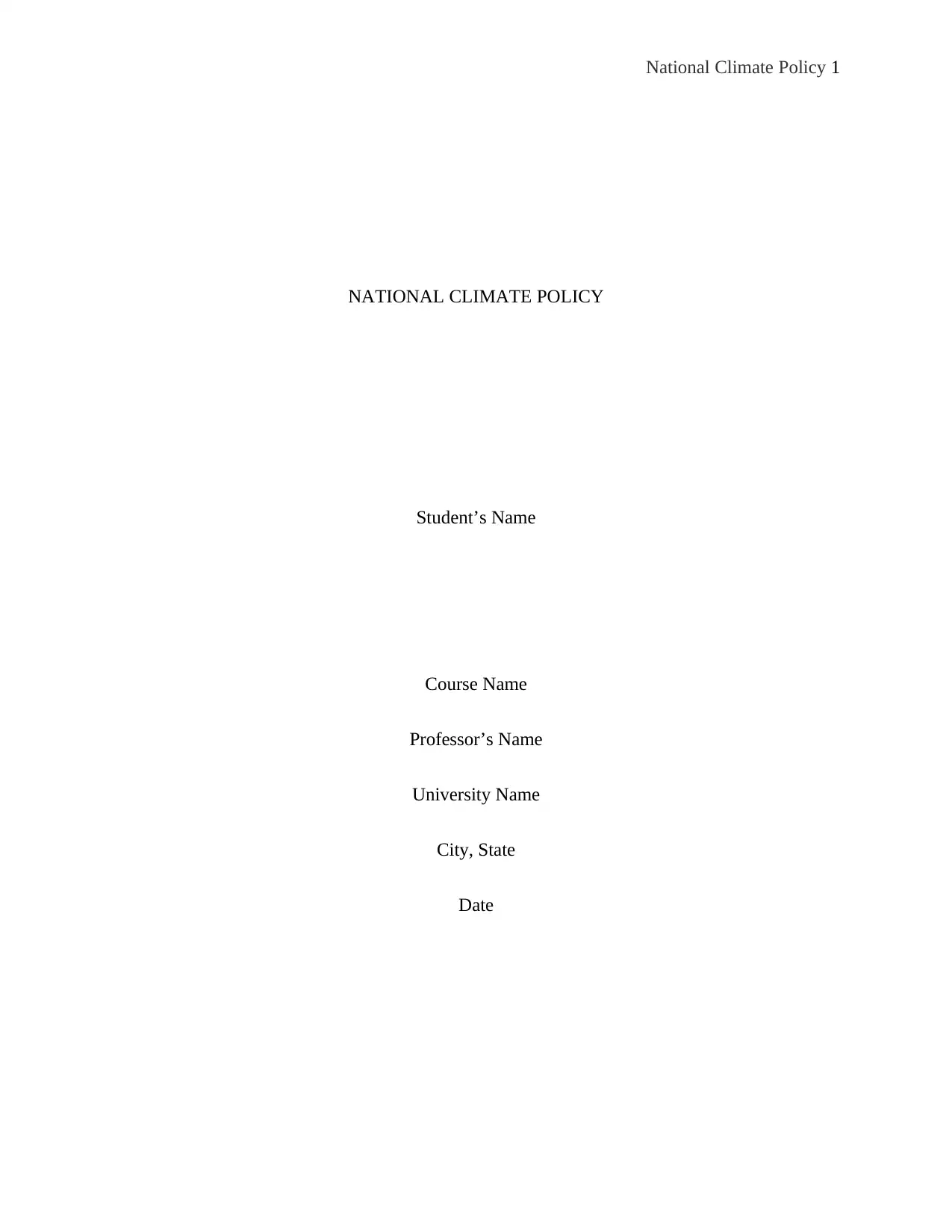
National Climate Policy 1
NATIONAL CLIMATE POLICY
Student’s Name
Course Name
Professor’s Name
University Name
City, State
Date
NATIONAL CLIMATE POLICY
Student’s Name
Course Name
Professor’s Name
University Name
City, State
Date
Paraphrase This Document
Need a fresh take? Get an instant paraphrase of this document with our AI Paraphraser
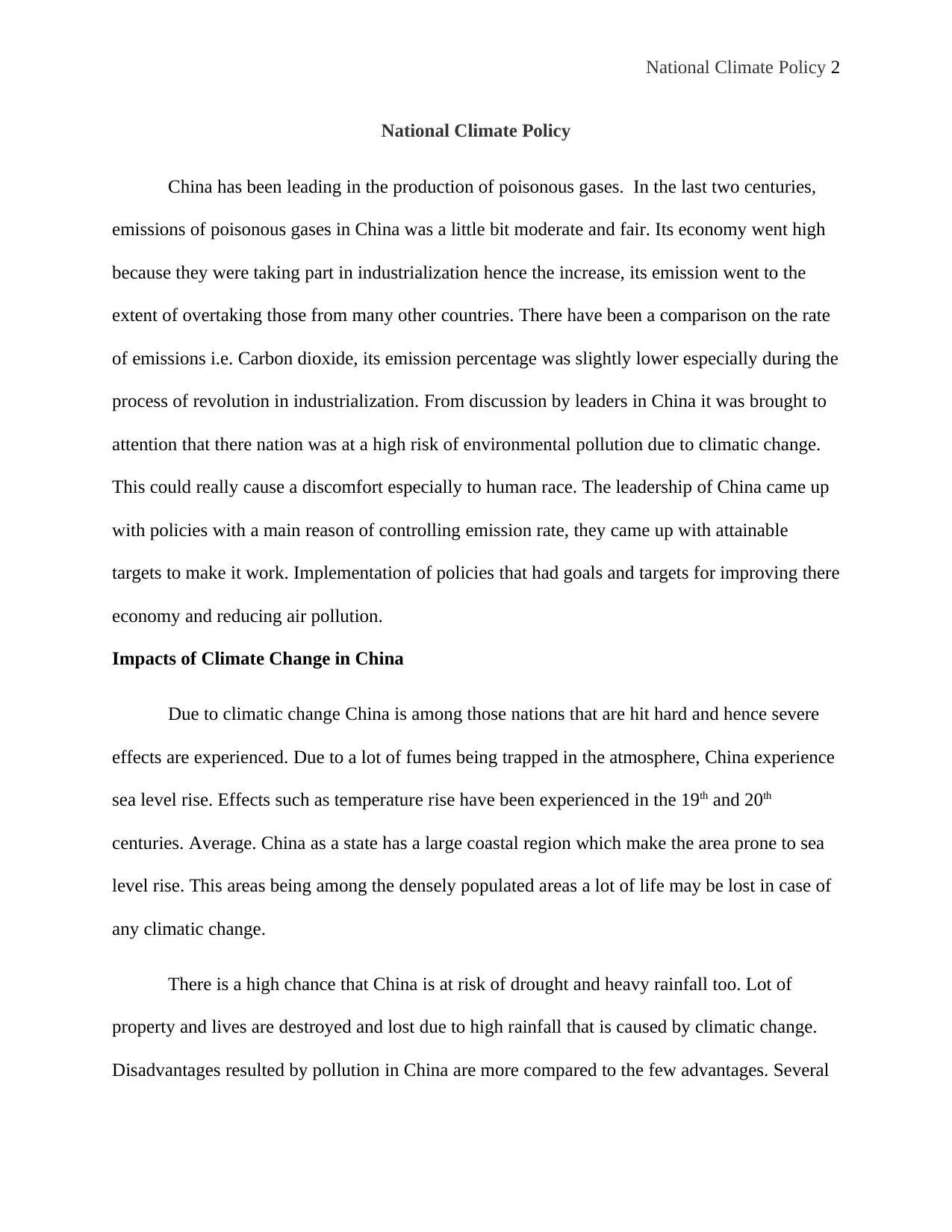
National Climate Policy 2
National Climate Policy
China has been leading in the production of poisonous gases. In the last two centuries,
emissions of poisonous gases in China was a little bit moderate and fair. Its economy went high
because they were taking part in industrialization hence the increase, its emission went to the
extent of overtaking those from many other countries. There have been a comparison on the rate
of emissions i.e. Carbon dioxide, its emission percentage was slightly lower especially during the
process of revolution in industrialization. From discussion by leaders in China it was brought to
attention that there nation was at a high risk of environmental pollution due to climatic change.
This could really cause a discomfort especially to human race. The leadership of China came up
with policies with a main reason of controlling emission rate, they came up with attainable
targets to make it work. Implementation of policies that had goals and targets for improving there
economy and reducing air pollution.
Impacts of Climate Change in China
Due to climatic change China is among those nations that are hit hard and hence severe
effects are experienced. Due to a lot of fumes being trapped in the atmosphere, China experience
sea level rise. Effects such as temperature rise have been experienced in the 19th and 20th
centuries. Average. China as a state has a large coastal region which make the area prone to sea
level rise. This areas being among the densely populated areas a lot of life may be lost in case of
any climatic change.
There is a high chance that China is at risk of drought and heavy rainfall too. Lot of
property and lives are destroyed and lost due to high rainfall that is caused by climatic change.
Disadvantages resulted by pollution in China are more compared to the few advantages. Several
National Climate Policy
China has been leading in the production of poisonous gases. In the last two centuries,
emissions of poisonous gases in China was a little bit moderate and fair. Its economy went high
because they were taking part in industrialization hence the increase, its emission went to the
extent of overtaking those from many other countries. There have been a comparison on the rate
of emissions i.e. Carbon dioxide, its emission percentage was slightly lower especially during the
process of revolution in industrialization. From discussion by leaders in China it was brought to
attention that there nation was at a high risk of environmental pollution due to climatic change.
This could really cause a discomfort especially to human race. The leadership of China came up
with policies with a main reason of controlling emission rate, they came up with attainable
targets to make it work. Implementation of policies that had goals and targets for improving there
economy and reducing air pollution.
Impacts of Climate Change in China
Due to climatic change China is among those nations that are hit hard and hence severe
effects are experienced. Due to a lot of fumes being trapped in the atmosphere, China experience
sea level rise. Effects such as temperature rise have been experienced in the 19th and 20th
centuries. Average. China as a state has a large coastal region which make the area prone to sea
level rise. This areas being among the densely populated areas a lot of life may be lost in case of
any climatic change.
There is a high chance that China is at risk of drought and heavy rainfall too. Lot of
property and lives are destroyed and lost due to high rainfall that is caused by climatic change.
Disadvantages resulted by pollution in China are more compared to the few advantages. Several
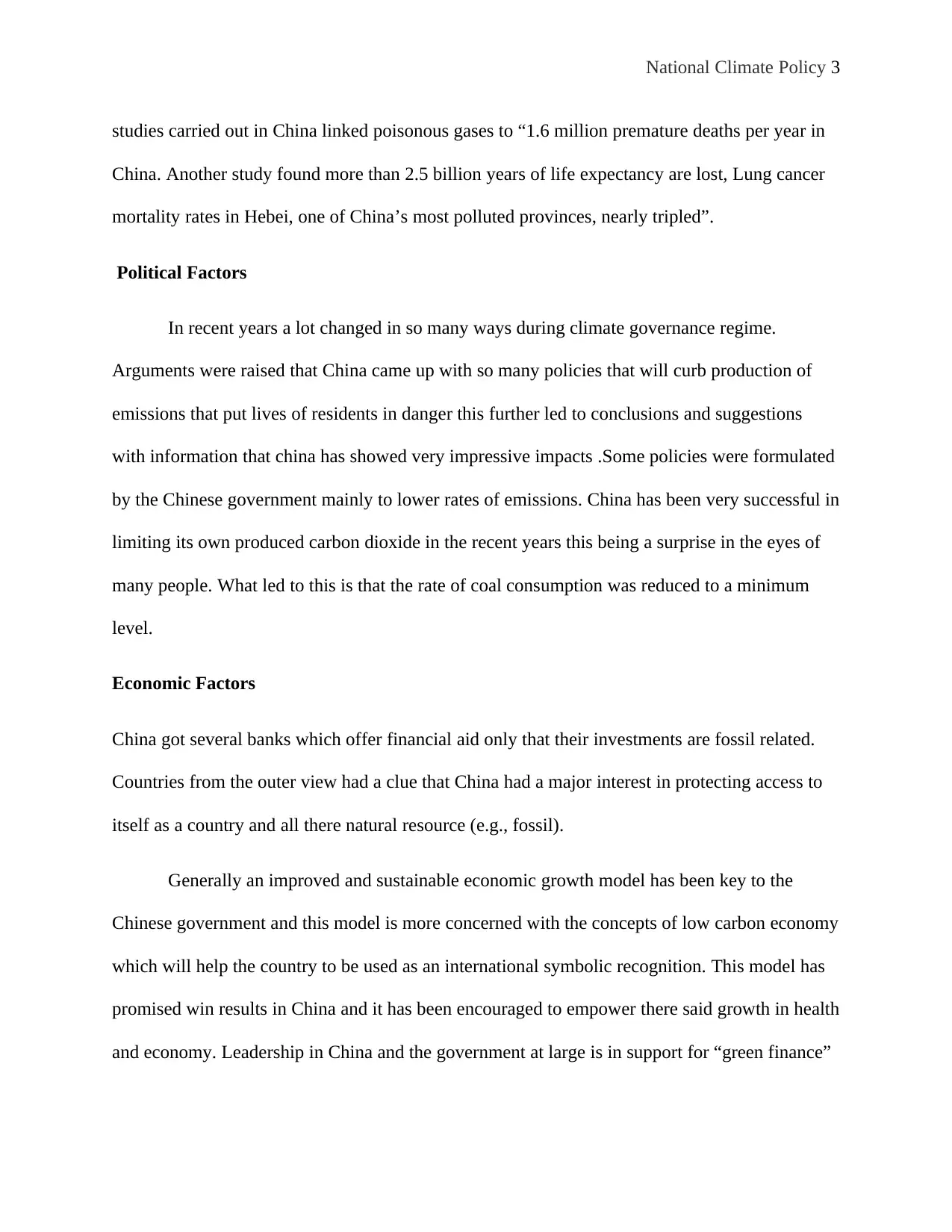
National Climate Policy 3
studies carried out in China linked poisonous gases to “1.6 million premature deaths per year in
China. Another study found more than 2.5 billion years of life expectancy are lost, Lung cancer
mortality rates in Hebei, one of China’s most polluted provinces, nearly tripled”.
Political Factors
In recent years a lot changed in so many ways during climate governance regime.
Arguments were raised that China came up with so many policies that will curb production of
emissions that put lives of residents in danger this further led to conclusions and suggestions
with information that china has showed very impressive impacts .Some policies were formulated
by the Chinese government mainly to lower rates of emissions. China has been very successful in
limiting its own produced carbon dioxide in the recent years this being a surprise in the eyes of
many people. What led to this is that the rate of coal consumption was reduced to a minimum
level.
Economic Factors
China got several banks which offer financial aid only that their investments are fossil related.
Countries from the outer view had a clue that China had a major interest in protecting access to
itself as a country and all there natural resource (e.g., fossil).
Generally an improved and sustainable economic growth model has been key to the
Chinese government and this model is more concerned with the concepts of low carbon economy
which will help the country to be used as an international symbolic recognition. This model has
promised win results in China and it has been encouraged to empower there said growth in health
and economy. Leadership in China and the government at large is in support for “green finance”
studies carried out in China linked poisonous gases to “1.6 million premature deaths per year in
China. Another study found more than 2.5 billion years of life expectancy are lost, Lung cancer
mortality rates in Hebei, one of China’s most polluted provinces, nearly tripled”.
Political Factors
In recent years a lot changed in so many ways during climate governance regime.
Arguments were raised that China came up with so many policies that will curb production of
emissions that put lives of residents in danger this further led to conclusions and suggestions
with information that china has showed very impressive impacts .Some policies were formulated
by the Chinese government mainly to lower rates of emissions. China has been very successful in
limiting its own produced carbon dioxide in the recent years this being a surprise in the eyes of
many people. What led to this is that the rate of coal consumption was reduced to a minimum
level.
Economic Factors
China got several banks which offer financial aid only that their investments are fossil related.
Countries from the outer view had a clue that China had a major interest in protecting access to
itself as a country and all there natural resource (e.g., fossil).
Generally an improved and sustainable economic growth model has been key to the
Chinese government and this model is more concerned with the concepts of low carbon economy
which will help the country to be used as an international symbolic recognition. This model has
promised win results in China and it has been encouraged to empower there said growth in health
and economy. Leadership in China and the government at large is in support for “green finance”
⊘ This is a preview!⊘
Do you want full access?
Subscribe today to unlock all pages.

Trusted by 1+ million students worldwide
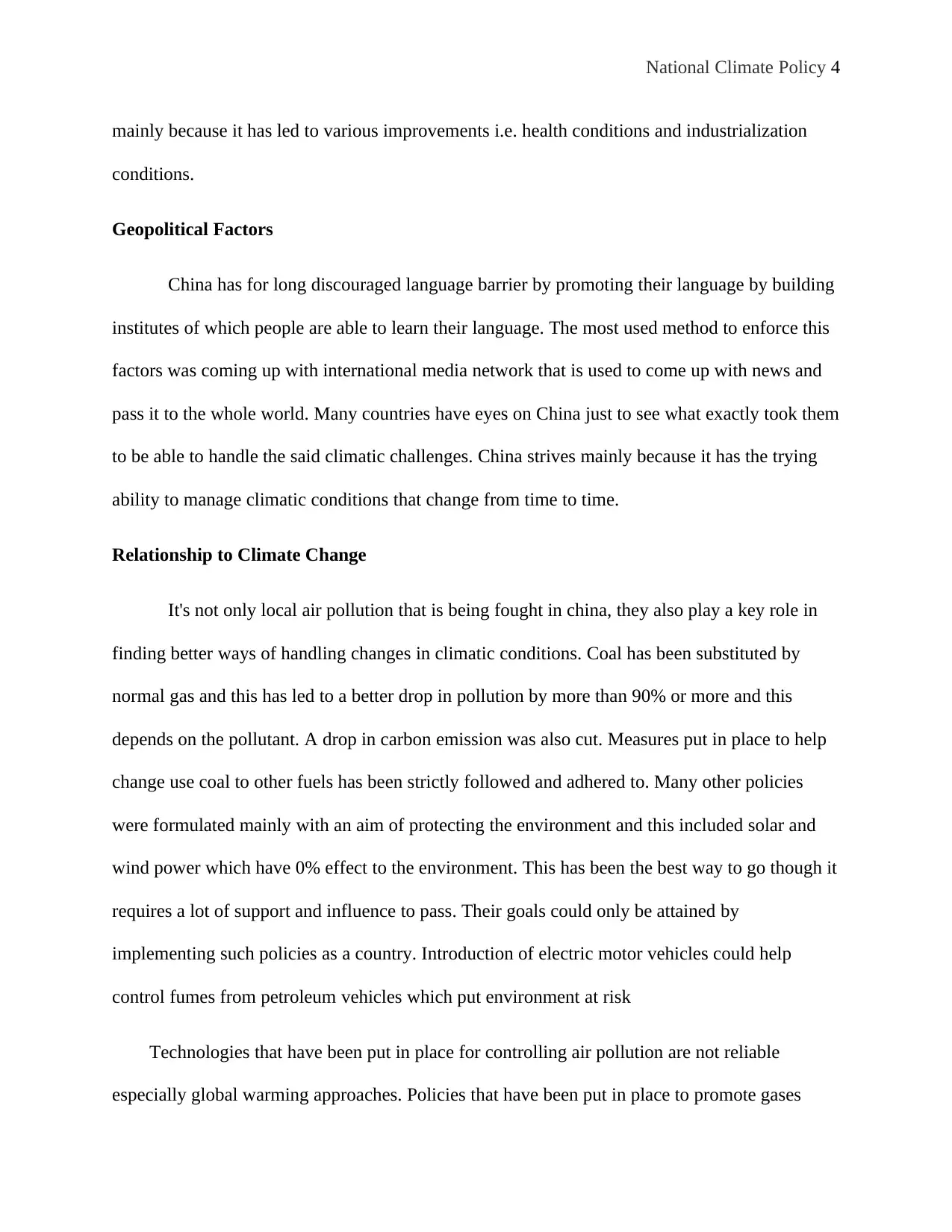
National Climate Policy 4
mainly because it has led to various improvements i.e. health conditions and industrialization
conditions.
Geopolitical Factors
China has for long discouraged language barrier by promoting their language by building
institutes of which people are able to learn their language. The most used method to enforce this
factors was coming up with international media network that is used to come up with news and
pass it to the whole world. Many countries have eyes on China just to see what exactly took them
to be able to handle the said climatic challenges. China strives mainly because it has the trying
ability to manage climatic conditions that change from time to time.
Relationship to Climate Change
It's not only local air pollution that is being fought in china, they also play a key role in
finding better ways of handling changes in climatic conditions. Coal has been substituted by
normal gas and this has led to a better drop in pollution by more than 90% or more and this
depends on the pollutant. A drop in carbon emission was also cut. Measures put in place to help
change use coal to other fuels has been strictly followed and adhered to. Many other policies
were formulated mainly with an aim of protecting the environment and this included solar and
wind power which have 0% effect to the environment. This has been the best way to go though it
requires a lot of support and influence to pass. Their goals could only be attained by
implementing such policies as a country. Introduction of electric motor vehicles could help
control fumes from petroleum vehicles which put environment at risk
Technologies that have been put in place for controlling air pollution are not reliable
especially global warming approaches. Policies that have been put in place to promote gases
mainly because it has led to various improvements i.e. health conditions and industrialization
conditions.
Geopolitical Factors
China has for long discouraged language barrier by promoting their language by building
institutes of which people are able to learn their language. The most used method to enforce this
factors was coming up with international media network that is used to come up with news and
pass it to the whole world. Many countries have eyes on China just to see what exactly took them
to be able to handle the said climatic challenges. China strives mainly because it has the trying
ability to manage climatic conditions that change from time to time.
Relationship to Climate Change
It's not only local air pollution that is being fought in china, they also play a key role in
finding better ways of handling changes in climatic conditions. Coal has been substituted by
normal gas and this has led to a better drop in pollution by more than 90% or more and this
depends on the pollutant. A drop in carbon emission was also cut. Measures put in place to help
change use coal to other fuels has been strictly followed and adhered to. Many other policies
were formulated mainly with an aim of protecting the environment and this included solar and
wind power which have 0% effect to the environment. This has been the best way to go though it
requires a lot of support and influence to pass. Their goals could only be attained by
implementing such policies as a country. Introduction of electric motor vehicles could help
control fumes from petroleum vehicles which put environment at risk
Technologies that have been put in place for controlling air pollution are not reliable
especially global warming approaches. Policies that have been put in place to promote gases
Paraphrase This Document
Need a fresh take? Get an instant paraphrase of this document with our AI Paraphraser
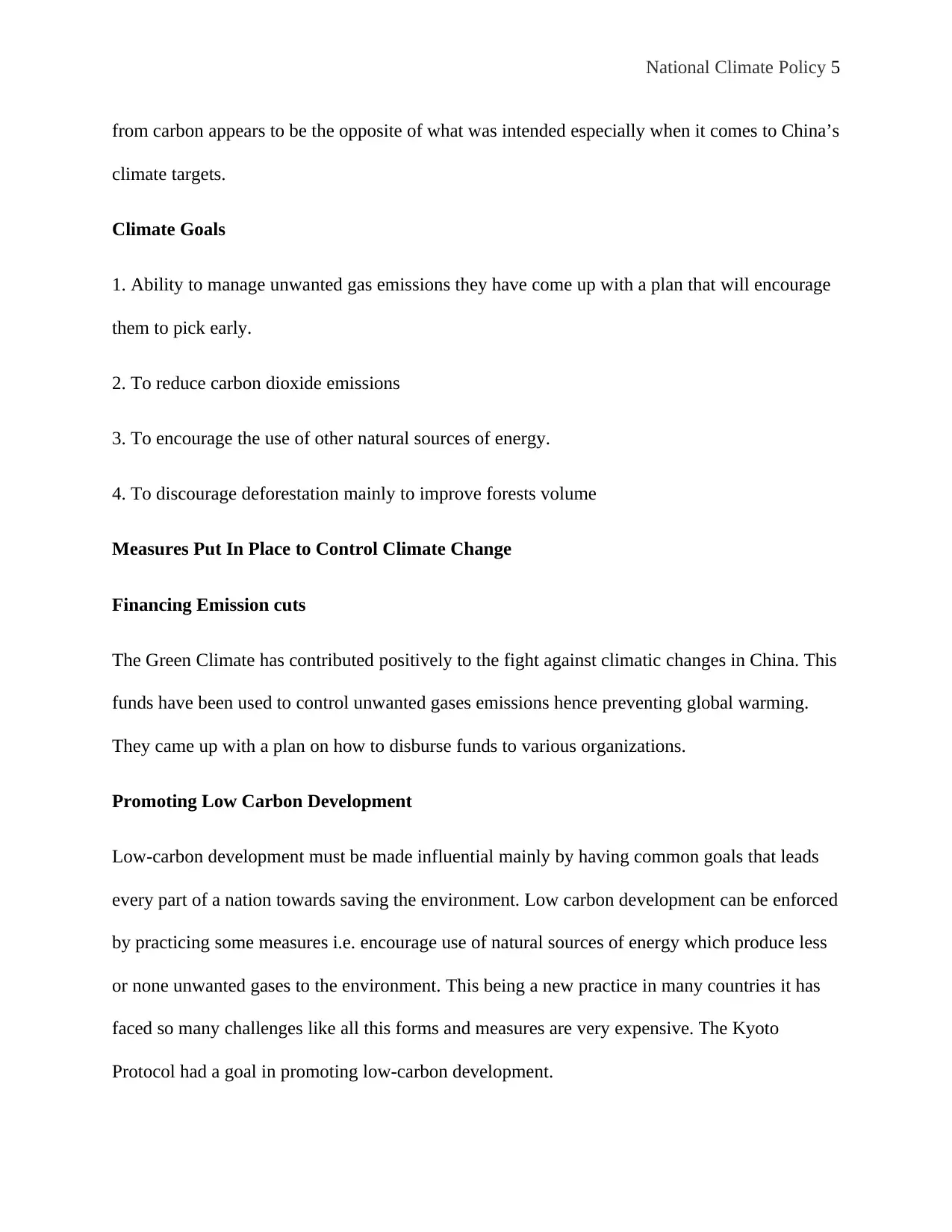
National Climate Policy 5
from carbon appears to be the opposite of what was intended especially when it comes to China’s
climate targets.
Climate Goals
1. Ability to manage unwanted gas emissions they have come up with a plan that will encourage
them to pick early.
2. To reduce carbon dioxide emissions
3. To encourage the use of other natural sources of energy.
4. To discourage deforestation mainly to improve forests volume
Measures Put In Place to Control Climate Change
Financing Emission cuts
The Green Climate has contributed positively to the fight against climatic changes in China. This
funds have been used to control unwanted gases emissions hence preventing global warming.
They came up with a plan on how to disburse funds to various organizations.
Promoting Low Carbon Development
Low-carbon development must be made influential mainly by having common goals that leads
every part of a nation towards saving the environment. Low carbon development can be enforced
by practicing some measures i.e. encourage use of natural sources of energy which produce less
or none unwanted gases to the environment. This being a new practice in many countries it has
faced so many challenges like all this forms and measures are very expensive. The Kyoto
Protocol had a goal in promoting low-carbon development.
from carbon appears to be the opposite of what was intended especially when it comes to China’s
climate targets.
Climate Goals
1. Ability to manage unwanted gas emissions they have come up with a plan that will encourage
them to pick early.
2. To reduce carbon dioxide emissions
3. To encourage the use of other natural sources of energy.
4. To discourage deforestation mainly to improve forests volume
Measures Put In Place to Control Climate Change
Financing Emission cuts
The Green Climate has contributed positively to the fight against climatic changes in China. This
funds have been used to control unwanted gases emissions hence preventing global warming.
They came up with a plan on how to disburse funds to various organizations.
Promoting Low Carbon Development
Low-carbon development must be made influential mainly by having common goals that leads
every part of a nation towards saving the environment. Low carbon development can be enforced
by practicing some measures i.e. encourage use of natural sources of energy which produce less
or none unwanted gases to the environment. This being a new practice in many countries it has
faced so many challenges like all this forms and measures are very expensive. The Kyoto
Protocol had a goal in promoting low-carbon development.
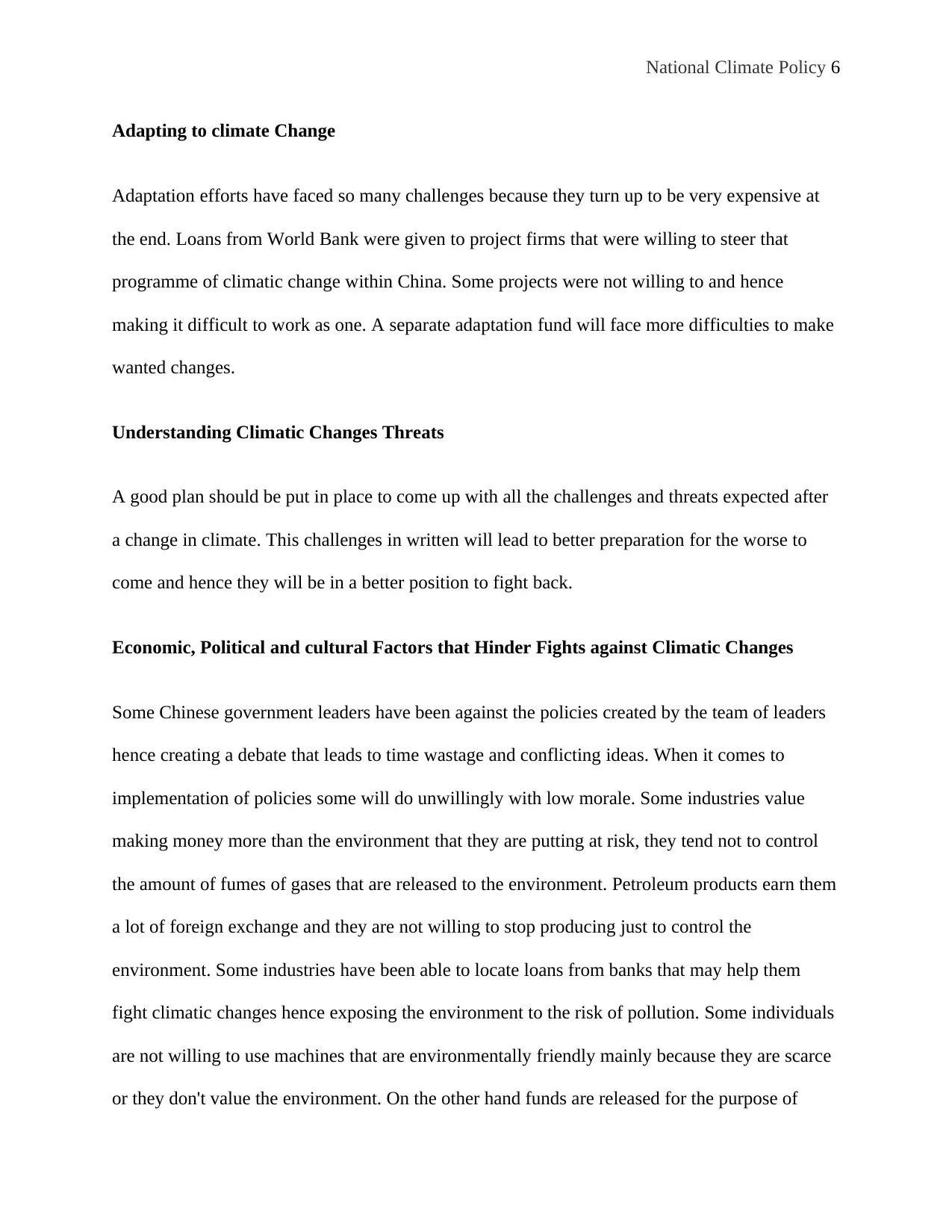
National Climate Policy 6
Adapting to climate Change
Adaptation efforts have faced so many challenges because they turn up to be very expensive at
the end. Loans from World Bank were given to project firms that were willing to steer that
programme of climatic change within China. Some projects were not willing to and hence
making it difficult to work as one. A separate adaptation fund will face more difficulties to make
wanted changes.
Understanding Climatic Changes Threats
A good plan should be put in place to come up with all the challenges and threats expected after
a change in climate. This challenges in written will lead to better preparation for the worse to
come and hence they will be in a better position to fight back.
Economic, Political and cultural Factors that Hinder Fights against Climatic Changes
Some Chinese government leaders have been against the policies created by the team of leaders
hence creating a debate that leads to time wastage and conflicting ideas. When it comes to
implementation of policies some will do unwillingly with low morale. Some industries value
making money more than the environment that they are putting at risk, they tend not to control
the amount of fumes of gases that are released to the environment. Petroleum products earn them
a lot of foreign exchange and they are not willing to stop producing just to control the
environment. Some industries have been able to locate loans from banks that may help them
fight climatic changes hence exposing the environment to the risk of pollution. Some individuals
are not willing to use machines that are environmentally friendly mainly because they are scarce
or they don't value the environment. On the other hand funds are released for the purpose of
Adapting to climate Change
Adaptation efforts have faced so many challenges because they turn up to be very expensive at
the end. Loans from World Bank were given to project firms that were willing to steer that
programme of climatic change within China. Some projects were not willing to and hence
making it difficult to work as one. A separate adaptation fund will face more difficulties to make
wanted changes.
Understanding Climatic Changes Threats
A good plan should be put in place to come up with all the challenges and threats expected after
a change in climate. This challenges in written will lead to better preparation for the worse to
come and hence they will be in a better position to fight back.
Economic, Political and cultural Factors that Hinder Fights against Climatic Changes
Some Chinese government leaders have been against the policies created by the team of leaders
hence creating a debate that leads to time wastage and conflicting ideas. When it comes to
implementation of policies some will do unwillingly with low morale. Some industries value
making money more than the environment that they are putting at risk, they tend not to control
the amount of fumes of gases that are released to the environment. Petroleum products earn them
a lot of foreign exchange and they are not willing to stop producing just to control the
environment. Some industries have been able to locate loans from banks that may help them
fight climatic changes hence exposing the environment to the risk of pollution. Some individuals
are not willing to use machines that are environmentally friendly mainly because they are scarce
or they don't value the environment. On the other hand funds are released for the purpose of
⊘ This is a preview!⊘
Do you want full access?
Subscribe today to unlock all pages.

Trusted by 1+ million students worldwide

National Climate Policy 7
fighting environmental risks but they end up being used for different purposes hence not
supporting the fight against climate changes. They should follow up to see how the funds issued
are being used, if the funds are misused it should be recovered and given to those who are
willing to take up the task.
fighting environmental risks but they end up being used for different purposes hence not
supporting the fight against climate changes. They should follow up to see how the funds issued
are being used, if the funds are misused it should be recovered and given to those who are
willing to take up the task.
Paraphrase This Document
Need a fresh take? Get an instant paraphrase of this document with our AI Paraphraser
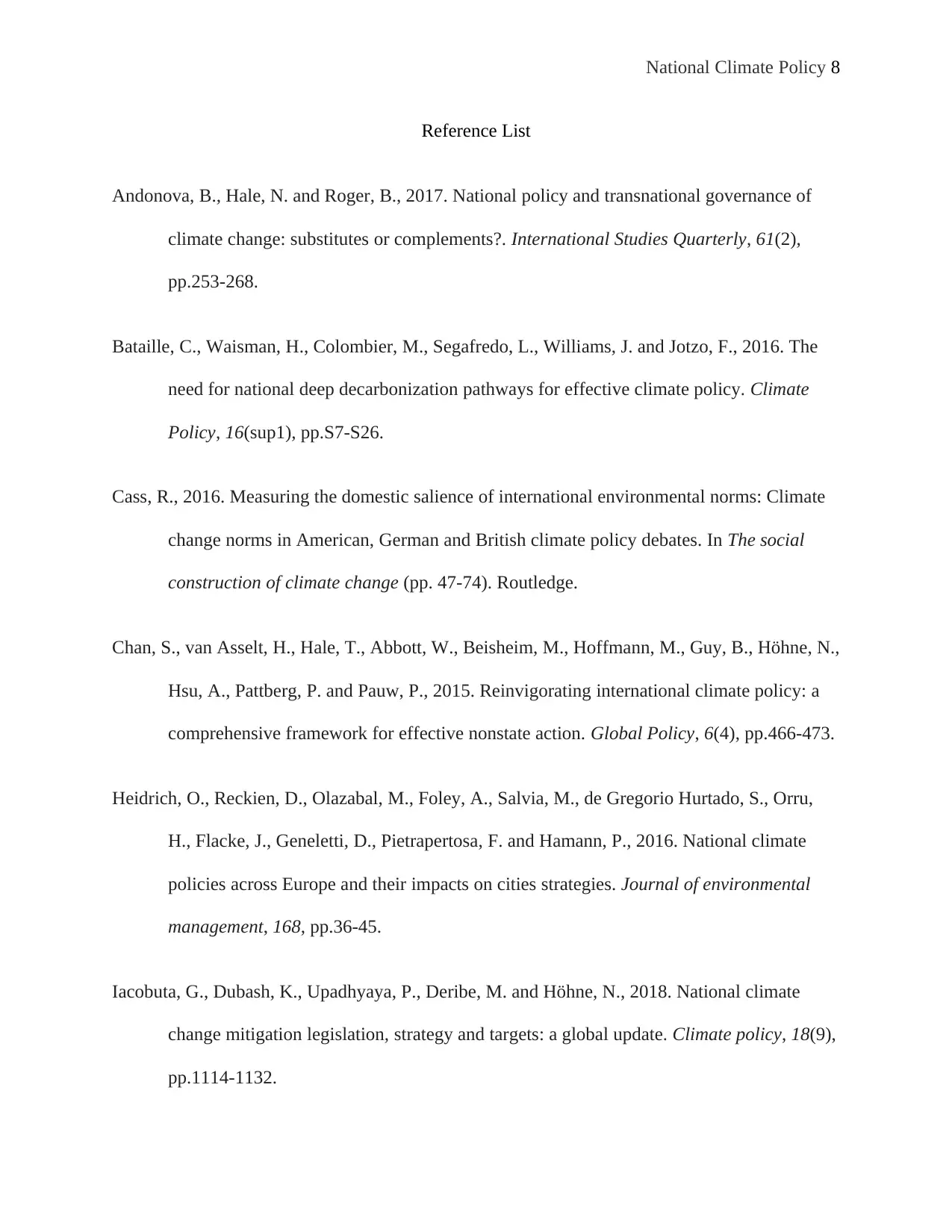
National Climate Policy 8
Reference List
Andonova, B., Hale, N. and Roger, B., 2017. National policy and transnational governance of
climate change: substitutes or complements?. International Studies Quarterly, 61(2),
pp.253-268.
Bataille, C., Waisman, H., Colombier, M., Segafredo, L., Williams, J. and Jotzo, F., 2016. The
need for national deep decarbonization pathways for effective climate policy. Climate
Policy, 16(sup1), pp.S7-S26.
Cass, R., 2016. Measuring the domestic salience of international environmental norms: Climate
change norms in American, German and British climate policy debates. In The social
construction of climate change (pp. 47-74). Routledge.
Chan, S., van Asselt, H., Hale, T., Abbott, W., Beisheim, M., Hoffmann, M., Guy, B., Höhne, N.,
Hsu, A., Pattberg, P. and Pauw, P., 2015. Reinvigorating international climate policy: a
comprehensive framework for effective nonstate action. Global Policy, 6(4), pp.466-473.
Heidrich, O., Reckien, D., Olazabal, M., Foley, A., Salvia, M., de Gregorio Hurtado, S., Orru,
H., Flacke, J., Geneletti, D., Pietrapertosa, F. and Hamann, P., 2016. National climate
policies across Europe and their impacts on cities strategies. Journal of environmental
management, 168, pp.36-45.
Iacobuta, G., Dubash, K., Upadhyaya, P., Deribe, M. and Höhne, N., 2018. National climate
change mitigation legislation, strategy and targets: a global update. Climate policy, 18(9),
pp.1114-1132.
Reference List
Andonova, B., Hale, N. and Roger, B., 2017. National policy and transnational governance of
climate change: substitutes or complements?. International Studies Quarterly, 61(2),
pp.253-268.
Bataille, C., Waisman, H., Colombier, M., Segafredo, L., Williams, J. and Jotzo, F., 2016. The
need for national deep decarbonization pathways for effective climate policy. Climate
Policy, 16(sup1), pp.S7-S26.
Cass, R., 2016. Measuring the domestic salience of international environmental norms: Climate
change norms in American, German and British climate policy debates. In The social
construction of climate change (pp. 47-74). Routledge.
Chan, S., van Asselt, H., Hale, T., Abbott, W., Beisheim, M., Hoffmann, M., Guy, B., Höhne, N.,
Hsu, A., Pattberg, P. and Pauw, P., 2015. Reinvigorating international climate policy: a
comprehensive framework for effective nonstate action. Global Policy, 6(4), pp.466-473.
Heidrich, O., Reckien, D., Olazabal, M., Foley, A., Salvia, M., de Gregorio Hurtado, S., Orru,
H., Flacke, J., Geneletti, D., Pietrapertosa, F. and Hamann, P., 2016. National climate
policies across Europe and their impacts on cities strategies. Journal of environmental
management, 168, pp.36-45.
Iacobuta, G., Dubash, K., Upadhyaya, P., Deribe, M. and Höhne, N., 2018. National climate
change mitigation legislation, strategy and targets: a global update. Climate policy, 18(9),
pp.1114-1132.
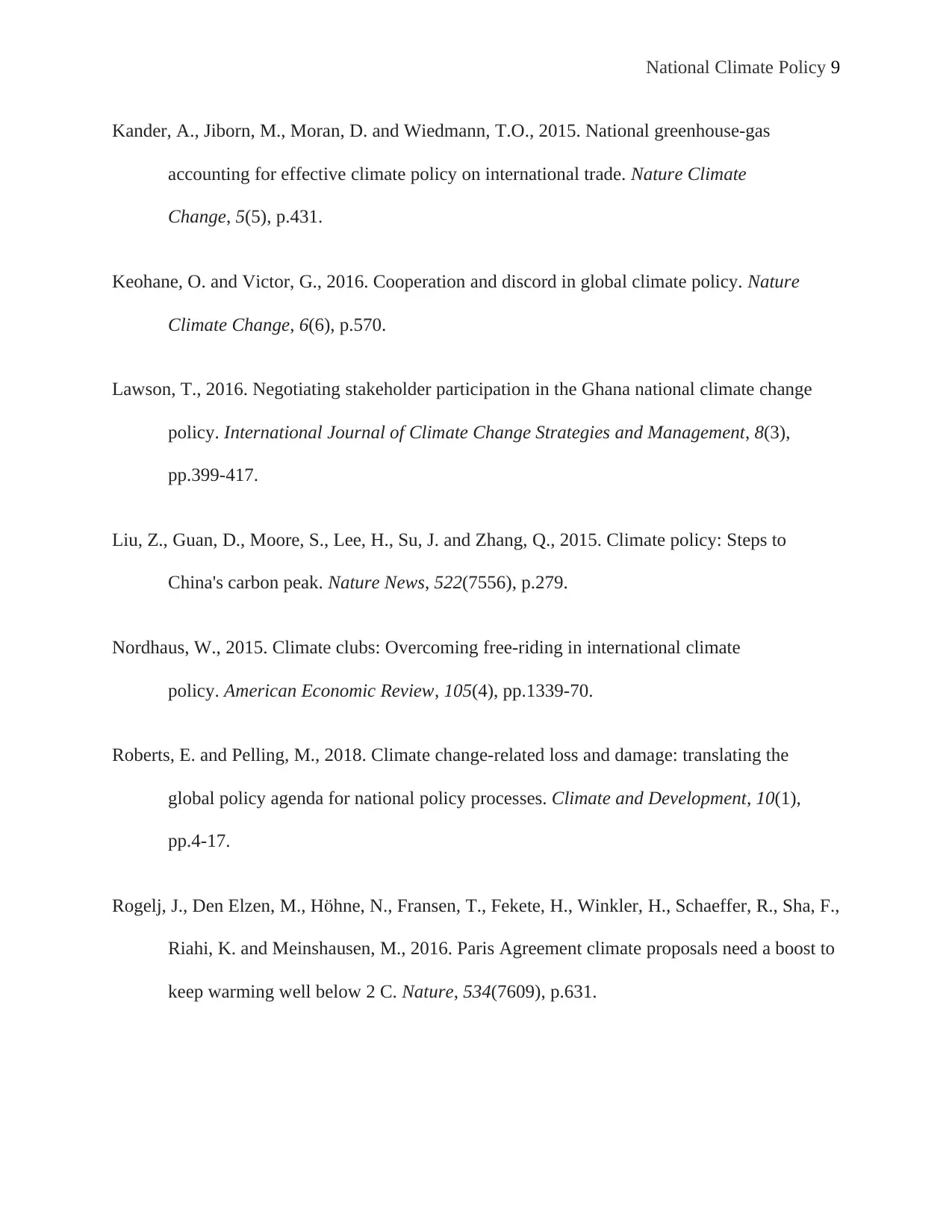
National Climate Policy 9
Kander, A., Jiborn, M., Moran, D. and Wiedmann, T.O., 2015. National greenhouse-gas
accounting for effective climate policy on international trade. Nature Climate
Change, 5(5), p.431.
Keohane, O. and Victor, G., 2016. Cooperation and discord in global climate policy. Nature
Climate Change, 6(6), p.570.
Lawson, T., 2016. Negotiating stakeholder participation in the Ghana national climate change
policy. International Journal of Climate Change Strategies and Management, 8(3),
pp.399-417.
Liu, Z., Guan, D., Moore, S., Lee, H., Su, J. and Zhang, Q., 2015. Climate policy: Steps to
China's carbon peak. Nature News, 522(7556), p.279.
Nordhaus, W., 2015. Climate clubs: Overcoming free-riding in international climate
policy. American Economic Review, 105(4), pp.1339-70.
Roberts, E. and Pelling, M., 2018. Climate change-related loss and damage: translating the
global policy agenda for national policy processes. Climate and Development, 10(1),
pp.4-17.
Rogelj, J., Den Elzen, M., Höhne, N., Fransen, T., Fekete, H., Winkler, H., Schaeffer, R., Sha, F.,
Riahi, K. and Meinshausen, M., 2016. Paris Agreement climate proposals need a boost to
keep warming well below 2 C. Nature, 534(7609), p.631.
Kander, A., Jiborn, M., Moran, D. and Wiedmann, T.O., 2015. National greenhouse-gas
accounting for effective climate policy on international trade. Nature Climate
Change, 5(5), p.431.
Keohane, O. and Victor, G., 2016. Cooperation and discord in global climate policy. Nature
Climate Change, 6(6), p.570.
Lawson, T., 2016. Negotiating stakeholder participation in the Ghana national climate change
policy. International Journal of Climate Change Strategies and Management, 8(3),
pp.399-417.
Liu, Z., Guan, D., Moore, S., Lee, H., Su, J. and Zhang, Q., 2015. Climate policy: Steps to
China's carbon peak. Nature News, 522(7556), p.279.
Nordhaus, W., 2015. Climate clubs: Overcoming free-riding in international climate
policy. American Economic Review, 105(4), pp.1339-70.
Roberts, E. and Pelling, M., 2018. Climate change-related loss and damage: translating the
global policy agenda for national policy processes. Climate and Development, 10(1),
pp.4-17.
Rogelj, J., Den Elzen, M., Höhne, N., Fransen, T., Fekete, H., Winkler, H., Schaeffer, R., Sha, F.,
Riahi, K. and Meinshausen, M., 2016. Paris Agreement climate proposals need a boost to
keep warming well below 2 C. Nature, 534(7609), p.631.
⊘ This is a preview!⊘
Do you want full access?
Subscribe today to unlock all pages.

Trusted by 1+ million students worldwide
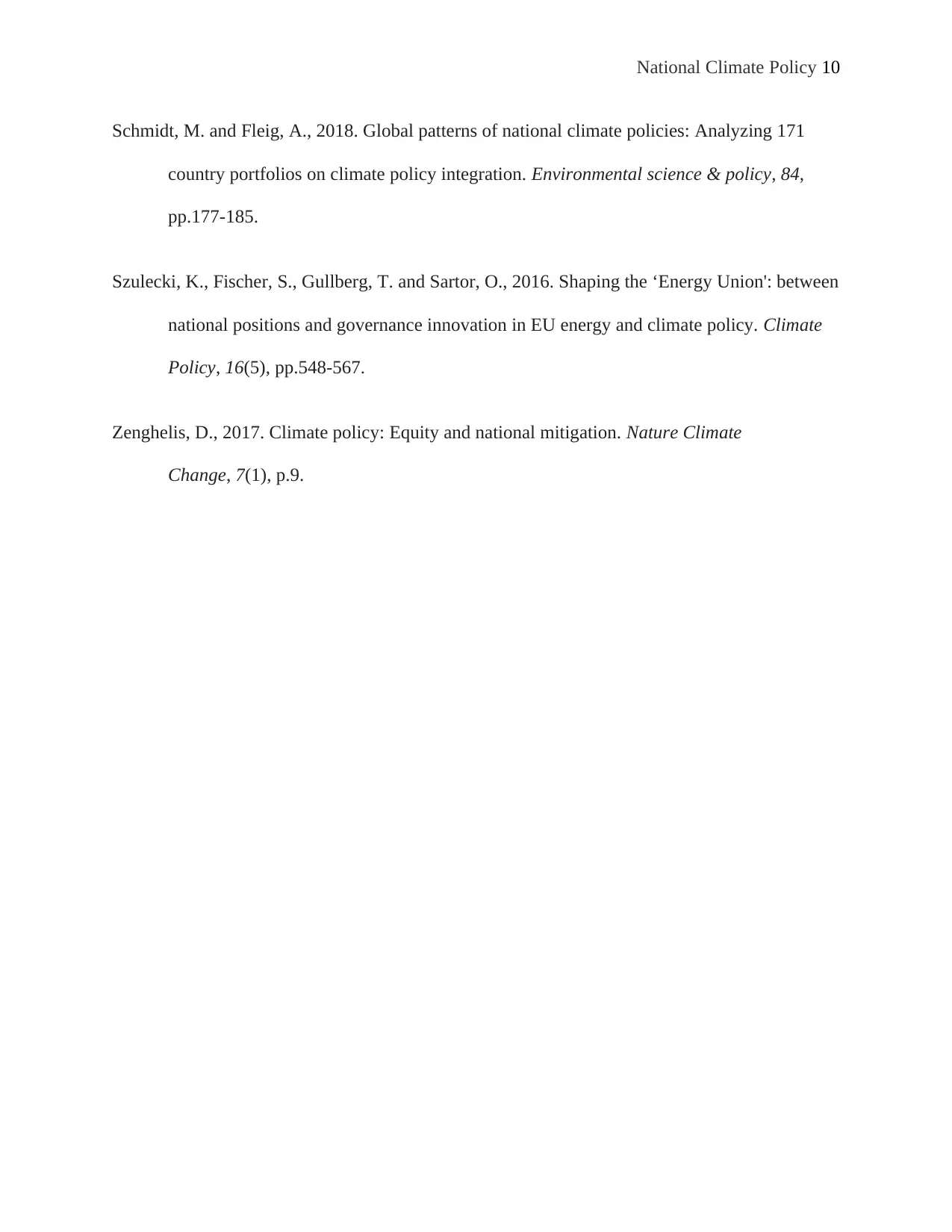
National Climate Policy 10
Schmidt, M. and Fleig, A., 2018. Global patterns of national climate policies: Analyzing 171
country portfolios on climate policy integration. Environmental science & policy, 84,
pp.177-185.
Szulecki, K., Fischer, S., Gullberg, T. and Sartor, O., 2016. Shaping the ‘Energy Union': between
national positions and governance innovation in EU energy and climate policy. Climate
Policy, 16(5), pp.548-567.
Zenghelis, D., 2017. Climate policy: Equity and national mitigation. Nature Climate
Change, 7(1), p.9.
Schmidt, M. and Fleig, A., 2018. Global patterns of national climate policies: Analyzing 171
country portfolios on climate policy integration. Environmental science & policy, 84,
pp.177-185.
Szulecki, K., Fischer, S., Gullberg, T. and Sartor, O., 2016. Shaping the ‘Energy Union': between
national positions and governance innovation in EU energy and climate policy. Climate
Policy, 16(5), pp.548-567.
Zenghelis, D., 2017. Climate policy: Equity and national mitigation. Nature Climate
Change, 7(1), p.9.
1 out of 10
Related Documents
Your All-in-One AI-Powered Toolkit for Academic Success.
+13062052269
info@desklib.com
Available 24*7 on WhatsApp / Email
![[object Object]](/_next/static/media/star-bottom.7253800d.svg)
Unlock your academic potential
Copyright © 2020–2025 A2Z Services. All Rights Reserved. Developed and managed by ZUCOL.





